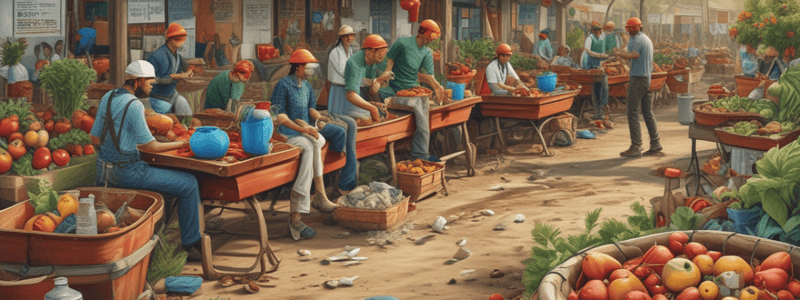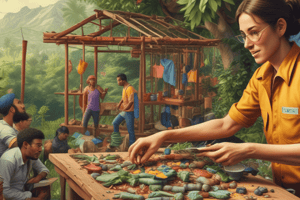Podcast
Questions and Answers
What is the main difference between a 'livelihood' and a 'sustainable livelihood'?
What is the main difference between a 'livelihood' and a 'sustainable livelihood'?
- A sustainable livelihood recovers from shocks, while a livelihood does not.
- A sustainable livelihood does not secure necessities, while a livelihood does.
- A livelihood includes assets, while a sustainable livelihood does not.
- A livelihood does not consider future assets, while a sustainable livelihood does. (correct)
How does being employed relate to risk management according to the Sustainable Livelihoods Framework?
How does being employed relate to risk management according to the Sustainable Livelihoods Framework?
- Employment only provides access to public risk management arrangements.
- Being employed does not impact risk management according to the framework.
- Employment helps prevent and mitigate risks for individuals. (correct)
- Being employed increases vulnerabilities in risk management.
What is a crucial aspect of a sustainable livelihood that distinguishes it from other forms of livelihood?
What is a crucial aspect of a sustainable livelihood that distinguishes it from other forms of livelihood?
- Undermining the natural resource base (correct)
- Having access to various informal risk management arrangements
- Excluding any market-based activities
- Recovering from stresses and shocks
In the context of livelihoods, what is meant by 'group-specific contextual assets'?
In the context of livelihoods, what is meant by 'group-specific contextual assets'?
What aspect shifts the mindset from work or employment to livelihood in the context of the Sustainable Livelihoods Framework?
What aspect shifts the mindset from work or employment to livelihood in the context of the Sustainable Livelihoods Framework?
Which factor is NOT considered when defining a 'sustainable livelihood'?
Which factor is NOT considered when defining a 'sustainable livelihood'?
What does social sustainability aim to minimize?
What does social sustainability aim to minimize?
Which of the following is NOT considered a component of human capital in the Sustainable Livelihood Framework?
Which of the following is NOT considered a component of human capital in the Sustainable Livelihood Framework?
What does natural capital in the Sustainable Livelihood Framework refer to?
What does natural capital in the Sustainable Livelihood Framework refer to?
Which of the following is NOT part of physical capital according to the text?
Which of the following is NOT part of physical capital according to the text?
What is the main focus of intergenerational equity as mentioned in the text?
What is the main focus of intergenerational equity as mentioned in the text?
In the context of the poor, what does economic sustainability aim to maintain?
In the context of the poor, what does economic sustainability aim to maintain?
What are the key elements of livelihood according to the text?
What are the key elements of livelihood according to the text?
How do policies, institutions, and processes impact livelihoods according to the Sustainable Livelihood Framework?
How do policies, institutions, and processes impact livelihoods according to the Sustainable Livelihood Framework?
Which of the following is a characteristic of livelihood strategies in the Sustainable Livelihood Framework?
Which of the following is a characteristic of livelihood strategies in the Sustainable Livelihood Framework?
What do policies, institutions, and processes in the Sustainable Livelihood Framework primarily influence?
What do policies, institutions, and processes in the Sustainable Livelihood Framework primarily influence?
In the context of the text, what do livelihood outcomes focus on?
In the context of the text, what do livelihood outcomes focus on?
What primarily determines access to decision-making bodies and sources of influence?
What primarily determines access to decision-making bodies and sources of influence?
What are common elements of livelihood outcomes according to the text?
What are common elements of livelihood outcomes according to the text?
What does it mean to be poor according to the text?
What does it mean to be poor according to the text?
Why is poverty described as the lack of access to a sustainable livelihood?
Why is poverty described as the lack of access to a sustainable livelihood?
What does experiencing 'capability failure' imply for individuals?
What does experiencing 'capability failure' imply for individuals?
What is necessary for addressing poverty?
What is necessary for addressing poverty?
How is being poor related to 'vulnerability' in the text?
How is being poor related to 'vulnerability' in the text?
In the context of livelihood outcomes, what is critical for sustainability?
In the context of livelihood outcomes, what is critical for sustainability?
What is implied by the statement 'Addressing poverty is not just for those who experience it in the present'?
What is implied by the statement 'Addressing poverty is not just for those who experience it in the present'?
What does the text suggest is an absolute necessity for individuals despite other advancements?
What does the text suggest is an absolute necessity for individuals despite other advancements?
What does the phrase 'Leave no one behind' imply in the context of poverty elimination according to the text?
What does the phrase 'Leave no one behind' imply in the context of poverty elimination according to the text?
Based on the text, what makes it challenging for poor individuals to manage or sustain themselves?
Based on the text, what makes it challenging for poor individuals to manage or sustain themselves?
Flashcards are hidden until you start studying
Study Notes
Sustainable Livelihood Framework
- The framework consists of five key components: Livelihood Assets, Vulnerability Context, Livelihood Strategies, Livelihood Outcomes, and Policies, Institutions, and Processes.
- It aims to understand how people achieve their livelihood objectives and how they can be supported or obstructed by policies, institutions, and processes.
Livelihood Assets
- The five types of livelihood assets are:
- Human Capital: skills, knowledge, health, and motivation that enable people to pursue livelihood strategies.
- Social Capital: social resources, networks, and relationships that support livelihoods.
- Physical Capital: basic infrastructure and producer goods needed to support livelihoods.
- Natural Capital: natural resource stocks from which resource flows and services are derived.
- Financial Capital: financial resources, income, savings, credit, and debit that people use to achieve their livelihood objectives.
Vulnerability Context
- The context in which people exist, characterized by:
- Critical trends (population, resource, economic, governance, technological, and environmental)
- Shocks (health, natural, economic, social, and conflict)
- Seasonality (of prices, production, health, and employment opportunities)
Livelihood Strategies
- Combination of activities and choices people make to achieve their livelihood goals
- Involves combining assets and is supported or obstructed by policies, institutions, and processes
Livelihood Outcomes
- The actual outcomes of livelihood strategies, including:
- Income targets
- Ability to send kids to school
- Ability to weather illnesses and disasters
- Ability to build a house
- Increased well-being
- Reduced vulnerability
- Improved food security
- More sustainable use of natural resource base
- Pride in one's job
- Cultural integrity and pride
- Dignity
- Business and personal reputation
- Ability to give back
Policies, Institutions, and Processes
- The structures and processes that transform and shape livelihoods
- Includes institutions, organizations, policies, legislations, and culture
- Affects access to various types of capital, the terms of exchange between different types of capital, and returns to any given livelihood strategy
Studying That Suits You
Use AI to generate personalized quizzes and flashcards to suit your learning preferences.




